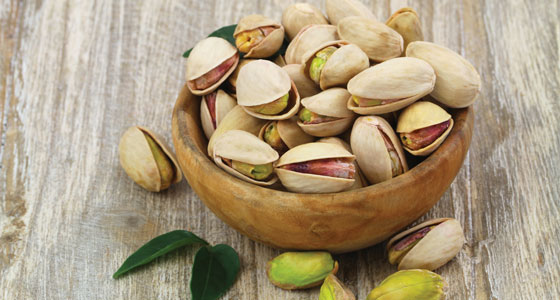Extracting phenolic compounds from pistachios; How posture influences taste
NEWS

Extracting phenolic compounds from pistachios
Pistachio nuts contain a vast array of phenolic and polyphenolic substances that have strong antioxidant properties. Currently, the use of natural antioxidants in the food industry has increased, resulting in a growing interest in improved extraction processes using GRAS (generally recognized as safe) solvents.
A study in the Journal of Food Science describes a process used to obtain phenolic compounds from pistachio nuts using a water/ethanol mixture under high temperature and pressure conditions. To optimize extraction conditions and the antioxidant activity of bioactive compounds, theoretical models were scanned against experimental data. The phenolic profile was dominated by several flavonoids and gallic acid derivatives.
A fitted model for phenolic compounds extraction presented a maximum predicted value under the following conditions: 220°C extraction temperature, 6.5 MPa pressure, and 50% ethanol. Beneath these conditions, phenolic extracts gave the highest radical scavenging capacity, similar to that reached by using commercial antioxidants. A mathematical model, namely a two-site desorption kinetic model, was shown to be suitable for the description of extraction kinetics under the optimal operation conditions. Overall, the process described in the study shows a potential alternative method for extraction of pistachio bioactive compounds that is safe, inexpensive, and may be adapted to applications at industrial scale.
Free-from food market continues to expand
The global free-from food market is likely to exceed revenues of $60 billion in 2019, according to research from Fact.MR, which cites mounting consumer awareness related to food allergies and intolerances, along with ascending health and wellness trends, as factors driving growth.
Healthier lifestyles have led to changing consumption patterns among consumers, who are increasingly resistant to chemical-based ingredients. Furthermore, increasing awareness related to clean label and natural products without sugar or fat has pumped up the acceptance of free-from products.
In addition, gluten intolerance and gluten sensitivity at the global level are rising, which has led to the occurrence of chronic ailments like gastrointestinal disorders and skin rashes. A rise in the prevalence of non-celiac gluten sensitivity has also helped drive consumption of free-from food.
Fact.MR reports that North America will retain its dominant position in the free-from food market, with revenues expected to exceed $19 billion in 2019 and demand underpinned by the relative economic potency of consumers.
Flavors that feed mind, body, soul
Ingredients that provide sustenance for healthy eating are top of mind for Americans, according to research from Mintel. But beyond a balanced diet, consumers are also seeking flavors that tap into relaxation and ingredients that feed the mind, body, and soul.
“We’re seeing Ayurvedic-inspired ingredients and adaptogens, botanical flavors and cannabidiol, or CBD, appearing in more packaged foods and drinks,” says Melanie Zanoza Bartelme, global food analyst. “At the same time, foodservice operators are getting creative with these flavors and ingredients in menu items. And it’s all in the name of stress release. With cannabis now legal in several U.S. states, and industrialized hemp production legal nationwide, consumer curiosity in alternative forms of relaxation is piqued.”
Another trend identified by Mintel is the link between fermented foods and health, with restaurants and retail brands turning to drinking vinegars, kimchi, and kombucha, as well as fermented foods derived from soybeans, including miso.
Mediterranean ingredients and flavors are also expanding consumers’ palates, according to Amanda Topper, associate director, foodservice research. “Americans are widely familiar with staple Middle Eastern foods like hummus, falafel, and zhug; because of this, consumers are becoming more receptive to regional, specialized flavors from specific Eastern Mediterranean locations like Israel, Yemen, Lebanon, and Syria.”
Topper notes that Indian cuisine is also in the spotlight, becoming mainstream in many parts of the country. Additionally, U.S. restaurants and retailers are drawing on the popularity of Japanese foods. “With Japanese street food appearing more and more in the media, and tourism to Japan on the rise, we expect to see an even greater focus on Japanese flavors and ingredients this year,” she notes.
Educating consumers on GMOs
While genetically modified organisms (GMOs) are considered safe by an overwhelming majority of scientists, only about one third of consumers share that view. A team of psychologists and biologists from the University of Rochester, the University of Amsterdam, and Cardiff University set out to discover if consumers’ attitudes would change if the public understood the underlying science better. The short answer is yes.
In a series of studies, the team discovered that people’s existing knowledge about GM food is the greatest determining factor of their attitudes toward the food. In fact, existing GM knowledge was more than 19 times higher as a determinant compared with the influence of demographic factors such as education, socioeconomic status, race, age, and gender.
In one study, participants were asked to rate their willingness to eat GM foods. Next, they were asked 11 general science knowledge questions. In a second study, participants took an additional quiz about the science, methods, and benefits of GM foods. The researchers found that specific knowledge about GM foods and procedures is independent of a person’s general science knowledge, making GM knowledge nearly twice as strong a predictor of GM attitudes.
The researchers followed up with a five-week longitudinal study to see if a lack of knowledge could be overcome by teaching participants the science behind GM technology. The team discovered that learning the underlying science led to more positive attitudes toward GM foods and a greater willingness to eat them.

How posture influences taste
A study published in the Journal of Consumer Research has found that posture impacts taste perception, with food tasting better when you’re sitting down. Lead author Dipayan Biswas, professor of marketing at the University of South Florida, looked at how the vestibular sense, responsible for balance, posture, and spatial orientation, interacts with the gustatory sensory system, which impacts taste and flavor.
He found that holding a standing posture for even a few minutes prompts physical stress, muting taste buds. Gravity pushes blood to the lower parts of the body, causing the heart to work harder to pump blood back up to the top of the body. This activates the hypothalamic-pituitary adrenal axis and leads to increased concentrations of the stress hormone cortisol. The chain reaction reduces sensory sensitivity, affecting food and beverage taste evaluation, temperature perception, and consumption volume.
During the study, 350 participants rated the tastiness of a pita chip. Those who were standing rated it less favorably than seated participants. Researchers then provided participants with brownies that were considered pleasant tasting. Seated participants rated them to be most delicious. However, when the baker added an extra ¼ cup of salt, standing participants perceived them to have a relatively more favorable taste than seated participants.
“This finding suggests that parents might be able to make unpleasant-tasting healthy foods seem more palatable to reluctant children by having them eat standing up (versus sitting down),” suggests Biswas. “In a similar vein, it might be beneficial to maintain a standing posture when consuming pharmaceutical products that have unpleasant tastes.”


